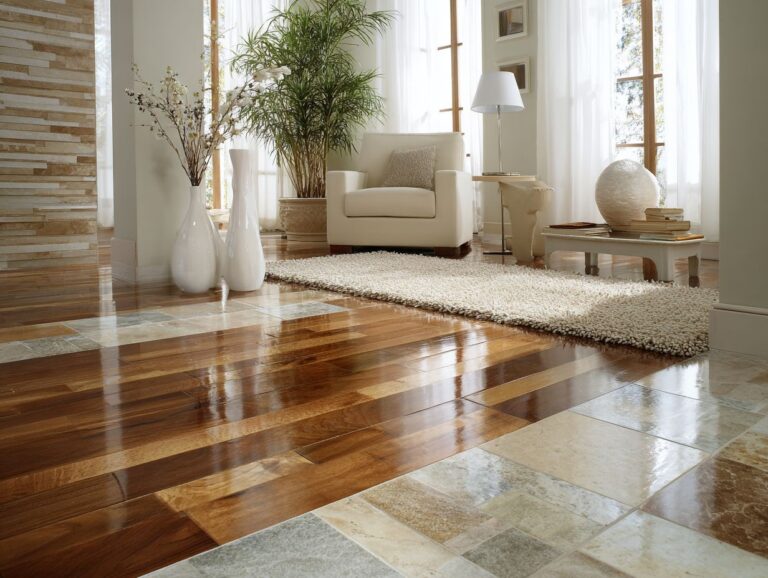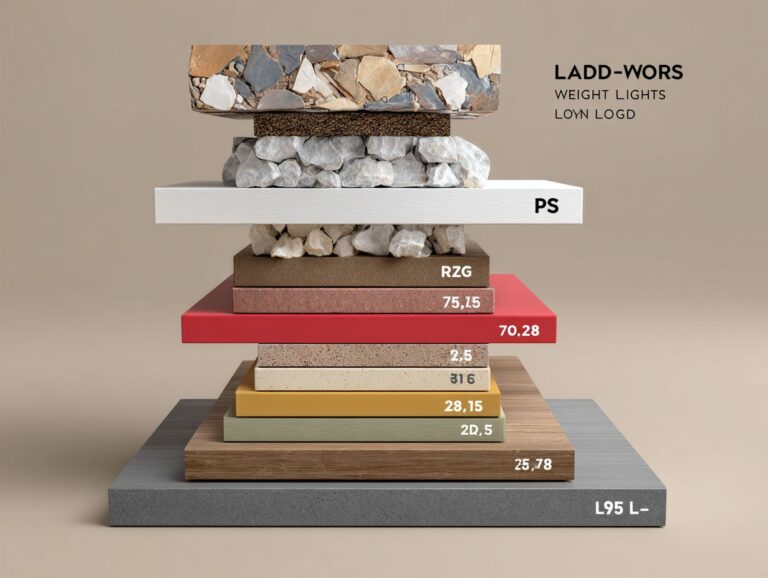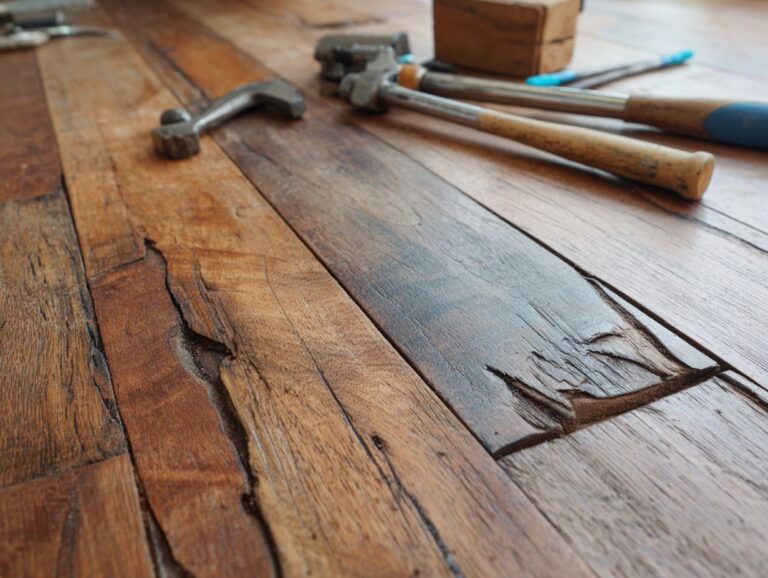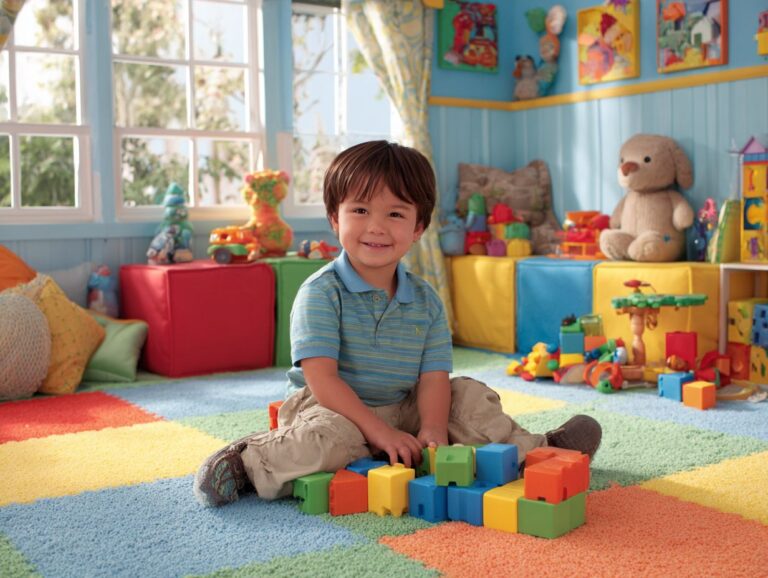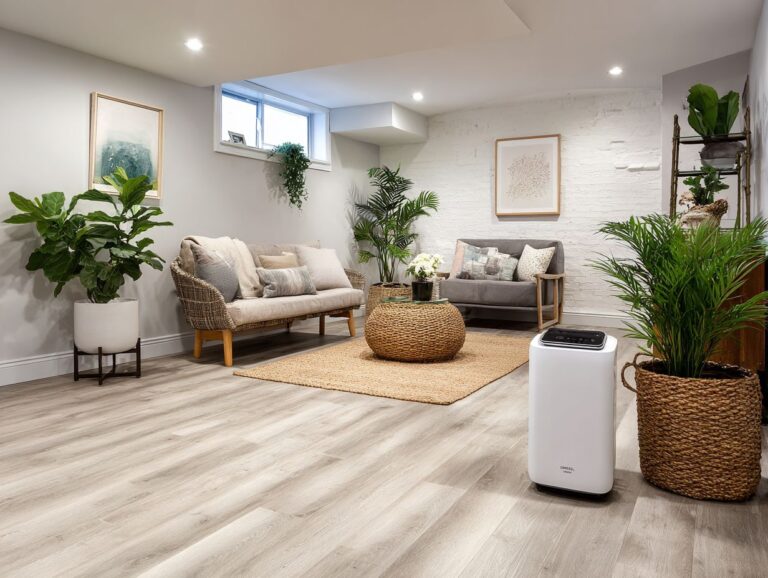Flooring for Allergies – Hypoallergenic Options
If you’re struggling with allergies, choosing the right flooring can make a significant difference in your home. Hypoallergenic options like hardwood flooring, tile flooring, and cork flooring help minimize allergens while enhancing your living space. This article discusses different types of flooring that are suitable for people with allergies, the advantages they provide, and advice on choosing the right one for you. Learn how the right flooring can make your home healthier!
Key Takeaways:
Contents
Knowing Allergies and Their Causes
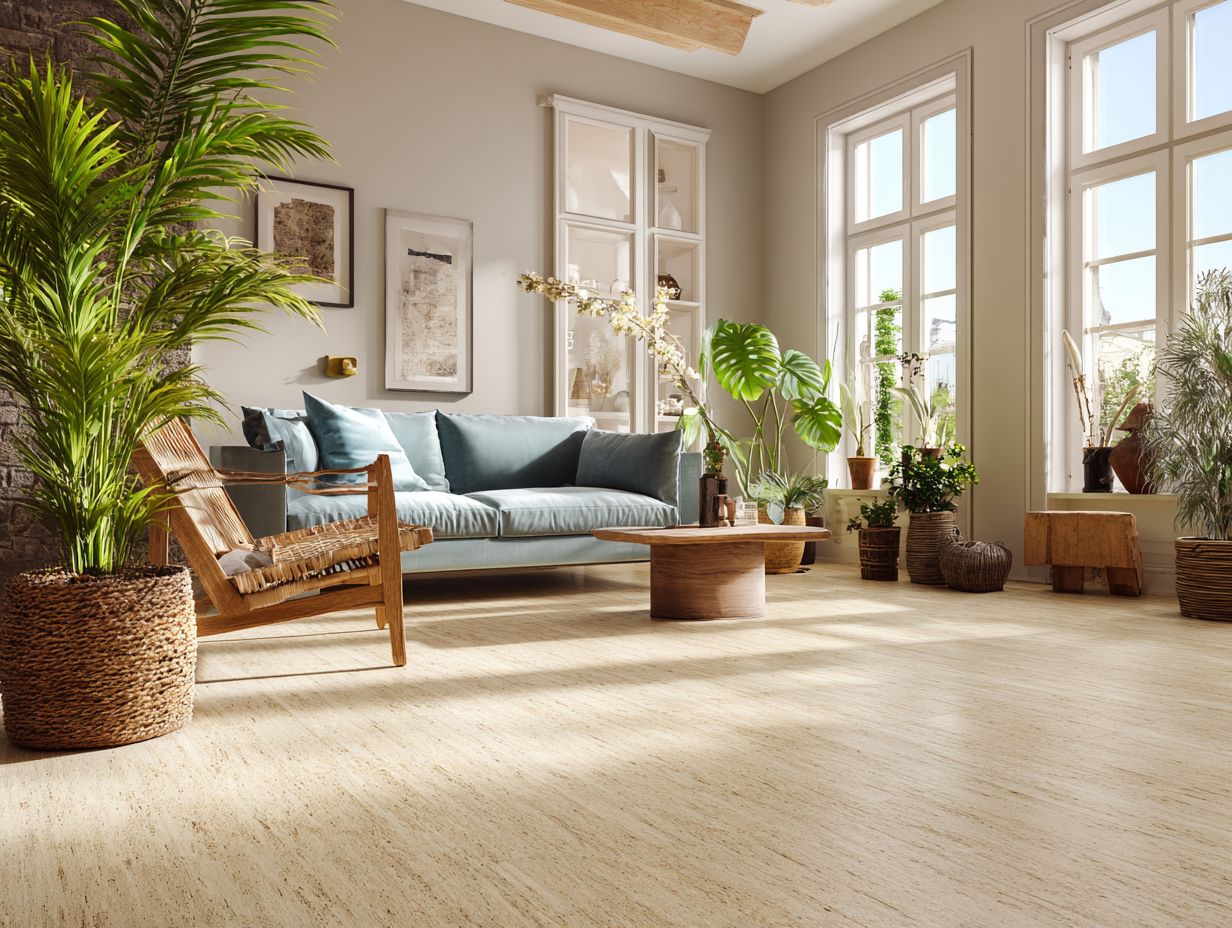
Common allergens like dust mites, pet dander, pollen, and mold often thrive in homes. It’s important to choose flooring that reduces these triggers.
Opt for hard surface flooring like tile or hardwood, which is less conducive to dust mites and mold growth compared to carpets.
Consider low-VOC adhesive options to reduce chemical off-gassing. For particularly sensitive areas, like kids’ rooms, bamboo flooring presents a hypoallergenic alternative.
Regular cleaning and upkeep are important; using a vacuum with a HEPA filter can reduce allergens.
Sources like the Centers for Disease Control offer detailed advice on how to manage indoor air quality, highlighting the benefits of choosing flooring that is good for health. If interested in maintaining a safe environment for pets, you might explore our insights on Pet-Safe Floor Cleaning Products and Methods.
The Importance of Hypoallergenic Flooring
Hypoallergenic flooring options significantly reduce allergen accumulation, helping to create a healthier living environment with improved air quality.
Materials such as bamboo, cork, and vinyl are popular hypoallergenic choices.
Bamboo, for instance, is known for its natural resistance to mold and mildew, while cork provides cushioning underfoot and is treated to repel dust and allergens.
Low VOC (volatile organic compounds) finishes are essential for maintaining indoor air quality; they release fewer harmful chemicals into the air.
Research from the Harvard T.H. Chan School of Public Health shows that using low-VOC products in homes leads to a 30% improvement in air quality. This makes hypoallergenic flooring a good choice for families focused on health.
Types of Hypoallergenic Flooring
Looking into different hypoallergenic flooring types shows choices that meet various needs and help keep homes cleaner.
Hypoallergenic Flooring Statistics
Hypoallergenic Flooring Statistics
Carpeted Flooring Issues: Dust and Allergen Comparison
Carpeted Flooring Issues: Adverse Health Outcomes
The Hypoallergenic Flooring Statistics data highlights the impact of carpeted flooring on dust accumulation, allergen levels, and associated health risks. This information is important for people with allergies and breathing problems, as well as for places looking to create healthier spaces.
Carpeted Flooring Issues showcase significant disparities in dust and allergen retention between carpeted and smooth floors. The data indicates that dust levels on carpeted floors are 6% higher than on smooth floors. This increase, while seemingly modest, can significantly affect indoor air quality over time, leading to accumulations that exacerbate allergies and respiratory conditions.
More strikingly, mite allergen levels are 614% higher in carpet dust compared to smooth floors. Dust mites often cause allergies, so it’s important to clean carpets frequently and think about using hypoallergenic flooring to reduce allergens.
- Adverse Health Outcomes: The data reveals a 4.64% increased risk of asthma due to carpets and mold presence at work. This highlights occupational health concerns, particularly in environments with inadequate ventilation or poor maintenance of carpeted surfaces.
- Additionally, childhood asthma shows a 1.94% increased risk linked to carpeted environments. This association emphasizes the importance of selecting flooring options that reduce allergen accumulation in homes and schools to safeguard children’s health.
In summary, the Hypoallergenic Flooring Statistics data suggests that while carpet offers comfort and aesthetic benefits, it poses significant challenges in allergen management and respiratory health. For individuals prone to allergies or in places such as schools and offices, looking into different flooring choices or putting in place strict cleaning routines can reduce these risks and improve indoor air quality.
Hardwood Flooring
Hardwood flooring, especially engineered hardwood, is a durable choice that promotes a hypoallergenic environment due to its low VOC emissions.
Selecting wood species like oak or maple can further minimize allergens, as they are less likely to harbor dust and allergens compared to carpets.
It’s important to clean regularly; use a vacuum with a HEPA filter and a damp mop each week to get rid of dust. To improve hypoallergenic properties, use a natural hardwood polish that has no harmful chemicals. This keeps the finish intact and seals the wood, stopping moisture from collecting and causing mold.
Laminate Flooring
Laminate flooring offers an affordable and water-resistant alternative, ideal for homes needing durability without sacrificing air quality.
Plus its moisture resistance, laminate flooring is hypoallergenic, thanks to its smooth surface that doesn’t trap dust, pet dander, or allergens.
Cleaning is simple: regularly sweep or vacuum, and occasionally mop with a damp cloth to keep it clean without using strong chemicals. The sturdy surface resists scratches and dents, ensuring durability even in high-traffic areas (for those interested in eco-friendly cleaning options, explore our green cleaning solutions for all flooring types).
Consider choosing brands like Pergo or Quick-Step, which offer various styles and promise simple care and long-lasting quality, leading to a healthier home.
Cork Flooring
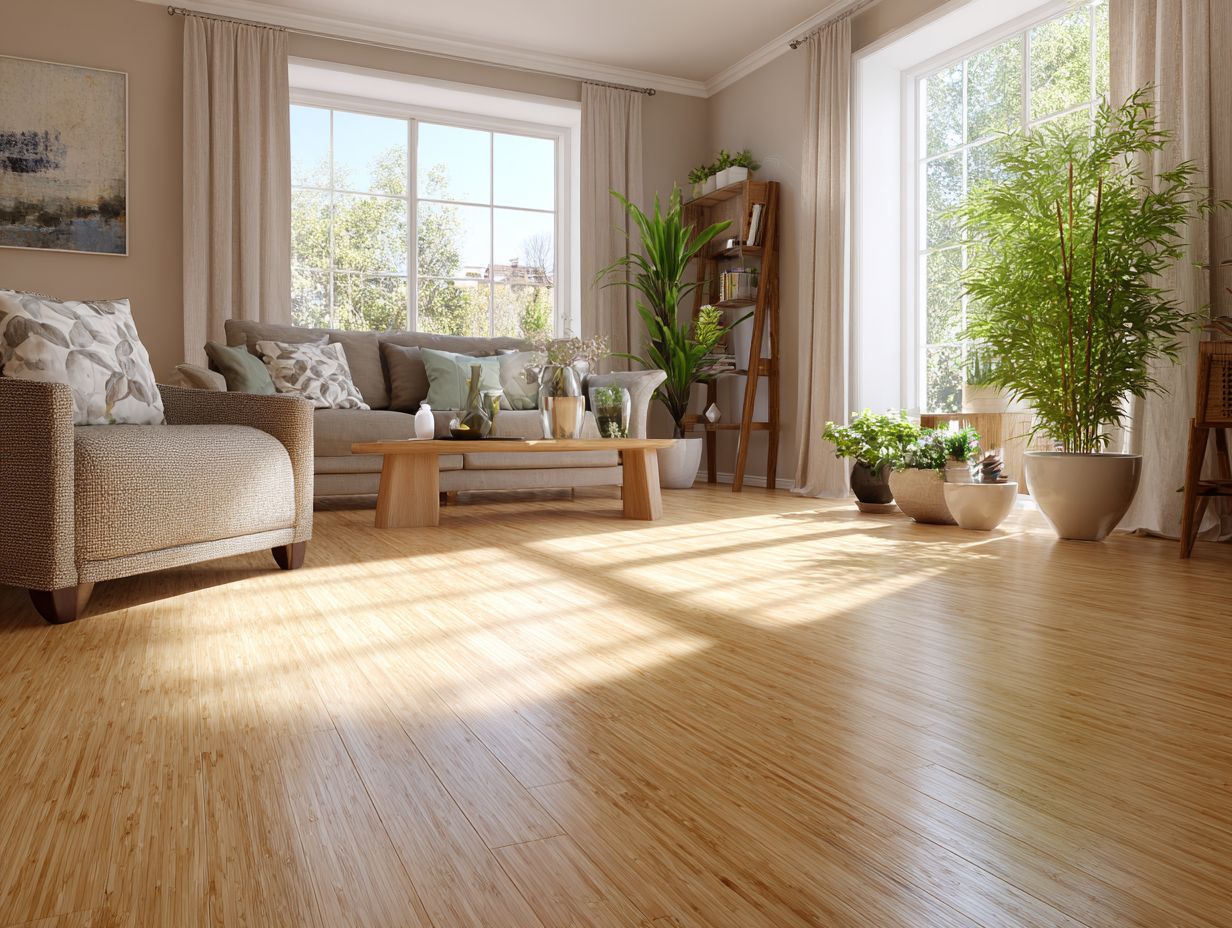
Cork flooring stands out as a natural hypoallergenic material, effective against dust mites and mold due to its moisture-resistant properties.
Plus its allergen-resistant benefits, cork is an eco-friendly choice, made from the bark of cork oak trees without harming the tree itself.
To maintain its hypoallergenic qualities, clean cork flooring regularly with a soft broom or vacuum designed for hard surfaces. Use a damp mop and a mild detergent for deeper cleans, avoiding excessive water, which can damage the material.
Applying a cork sealant regularly can extend its lifespan and protect it from harm, ensuring your item stays in good shape.
Vinyl Flooring
Vinyl flooring is a flexible and affordable choice that offers style and is good for people with allergies, providing a safe space for them.
Vinyl flooring today has little VOC, ensuring it is safe for indoor air quality. To maintain its hypoallergenic properties, regular cleaning is essential.
Opt for a damp mop with a gentle, eco-friendly cleaner to avoid residual chemicals. Brands like Karndean and Mannington offer antimicrobial surfaces, further reducing allergens.
Choosing vinyl planks with a textured finish enhances their appearance and provides a non-slip surface, which is useful for high-traffic areas in your home.
Tile Flooring
Tile flooring provides a waterproof and hypoallergenic solution, though grout lines may require careful maintenance to prevent mold growth.
Its smooth surface stops dust and pet dander from sticking, which is helpful for people with allergies. For better results, apply a good sealant on grout lines to stop moisture build-up.
For routine cleaning, a mixture of vinegar and water works remarkably well, ensuring that dirt doesn’t promote mold growth. Keep in mind that cracked grout can be challenging to repair.
Regular inspections and touch-ups are essential to maintain both the aesthetic and functional qualities of your tile flooring.
Carpet Alternatives
Opting for carpet alternatives such as low pile carpets can effectively reduce allergen accumulation while still offering comfort and warmth.
Low pile carpets, including Berber and Saxony styles, are excellent choices for hypoallergenic environments. Berber carpets, known for their tight weave, are less likely to trap dust, while Saxony carpets provide a softer feel without excessive fluff.
Maintaining these carpets involves regular vacuuming with a HEPA filter vacuum and occasional deep cleaning with hot water extraction to reduce allergens.
Consider using washable area rugs, which can easily be cleaned and replaced, further enhancing your home’s air quality.
Benefits of Hypoallergenic Flooring
Hypoallergenic flooring helps lower allergens and also provides other advantages for a healthier home.
Reduced Allergen Accumulation
Hypoallergenic flooring can reduce allergen accumulation by up to 80%, significantly lowering exposure to dust mites, pet dander, and other irritants.
For example, changing to a hard surface like luxury vinyl or laminate removes carpet fibers where allergens gather and makes cleaning easier.
Real-world results from a family’s home in Denver showed a 50% reduction in asthma-related doctor visits after installing these flooring options.
Using a microfiber mop can improve cleaning by keeping surfaces free from allergens. Adding air purification systems can improve indoor air quality, leading to a healthier space overall.
Easy Maintenance and Cleaning
Keeping hypoallergenic flooring clean is simple; regular cleaning and using a vacuum with a HEPA filter can help control allergens.
For optimal care, adhere to a weekly cleaning routine.
For hardwood or laminate floors, use a microfiber mop to capture dust without scratching surfaces. Carpets and rugs need to be vacuumed with a HEPA filter at least twice a week. Tile floors need to be cleaned with a mild cleaner every two weeks.
To deal with ongoing allergens, it is useful to steam clean your carpets and rugs every few months. Always check that cleaning products do not contain strong chemicals to keep the allergy-friendly benefits of your flooring.
Improved Indoor Air Quality
Choosing hypoallergenic flooring leads to improved indoor air quality, often reducing airborne allergens and harmful VOC emissions by 50% or more.
Materials such as bamboo, cork, and low-VOC vinyl are excellent choices.
Bamboo is eco-friendly and can resist mold and bacteria. Cork naturally absorbs allergens and repels insects, making it a practical option. For families with pets or small children, low-VOC vinyl provides durability without harmful emissions.
According to a study by the Environmental Protection Agency, homes using these flooring types reported a significant decrease in respiratory issues among inhabitants. Choose certified products to achieve lower emissions and improved air quality.
Choosing the Right Hypoallergenic Flooring
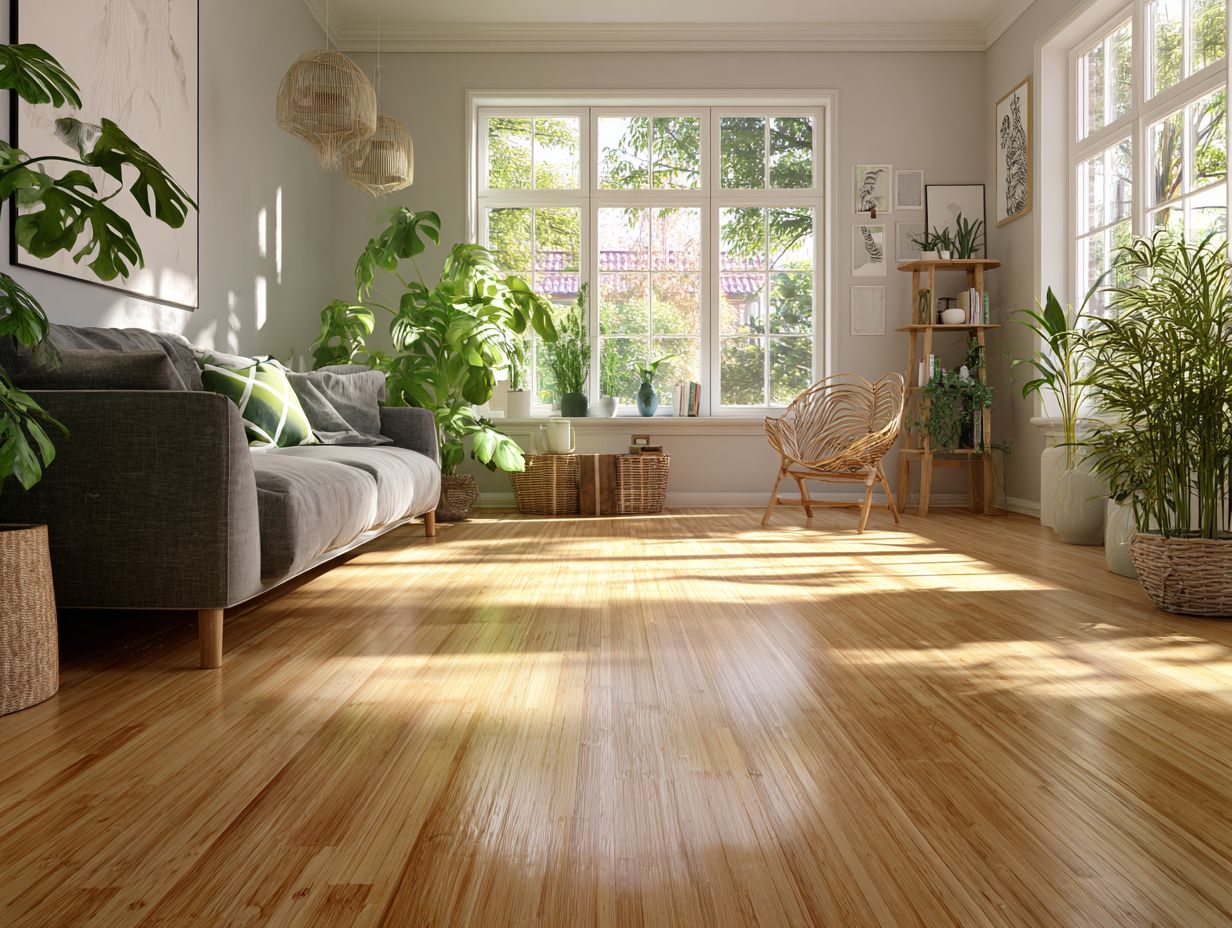
Choosing the right hypoallergenic flooring means looking at things like allergies, how long it lasts, and price to fit both health needs and budget.
Considerations for Allergies
When choosing flooring, it’s essential to consider specific allergens present in your home, as different materials can greatly affect allergy symptoms.
For individuals sensitive to pet dander and dust mites, opt for hard surfaces like tile or hardwood, which are easier to clean and do not harbor allergens.
Alternatively, consider luxury vinyl, which offers warmth while maintaining a low dust retention. Avoid carpets, as they can trap allergens, unless you choose low-pile options that are easier to maintain.
Using a vacuum with a HEPA filter and performing regular deep cleans can further reduce allergen exposure, creating a healthier living environment.
Durability and Longevity
Durability is important when choosing hypoallergenic flooring; materials such as tile and hardwood can last for many years with proper maintenance.
For example, porcelain tile can endure heavy foot traffic and typically comes with a warranty of up to 50 years, while solid hardwood often has a 30-year warranty but requires periodic refinishing to maintain its appearance.
Engineered hardwood resembles traditional hardwood but may need replacing every 15-20 years depending on the thickness of the top layer.
Regular upkeep, like sweeping and damp mopping, is important for all types to extend their life and keep them safe and good for allergies in your home.
Cost Factors
Knowing what affects the price of hypoallergenic flooring is important, since costs can vary from $1 to $10 per square foot based on the type of material.
For instance, laminate flooring typically costs about $1.50 to $3 per square foot, offering an affordable and easy-to-install option.
Engineered hardwood, priced between $4 and $8, provides a more upscale look while still minimizing allergens due to its sealed surface.
Luxury vinyl, ranging from $2 to $6, is waterproof and durable.
While initial costs may be high, cleaner air can reduce health expenses later, making it beneficial over time.
Installation of Hypoallergenic Flooring
It is important to install hypoallergenic flooring properly to fully benefit from it, whether you decide to hire professionals or do it yourself.
Professional vs. DIY Installation
Deciding whether to hire a professional or do it yourself can influence the quality of hypoallergenic flooring. Professionals typically have skill and offer a warranty.
On one hand, professional installation typically costs between $3 to $5 per square foot, ensuring that the flooring adheres correctly and prolongs the product’s life. Professionals use specialized tools and techniques, minimizing installation errors and maximizing durability.
On the other hand, a DIY approach can cut costs significantly, often going as low as $1 per square foot for materials. This option requires renting tools like a flooring nailer and may lead to subpar results without experience.
Weigh your budget against the desired quality to make an informed decision.
Preparing Your Home for Installation
Getting your home ready for new hypoallergenic flooring involves a few steps. This helps make the installation go smoothly and gives the best results after it’s done.
- Start by clearing the installation area of all furniture, ensuring you provide enough space for workers to maneuver.
- Next, thoroughly clean the subfloors to remove dust and debris, which can interfere with adhesion. It’s important to check for water problems; use a moisture meter to see how much water is present, as too much can harm the flooring.
- Keep the climate steady with a constant temperature to support the correct expansion and contraction of the flooring during installation.
Maintaining Hypoallergenic Flooring
Regular upkeep of hypoallergenic flooring is key to keeping its advantages and maintaining an allergen-free space.
Regular Cleaning Practices
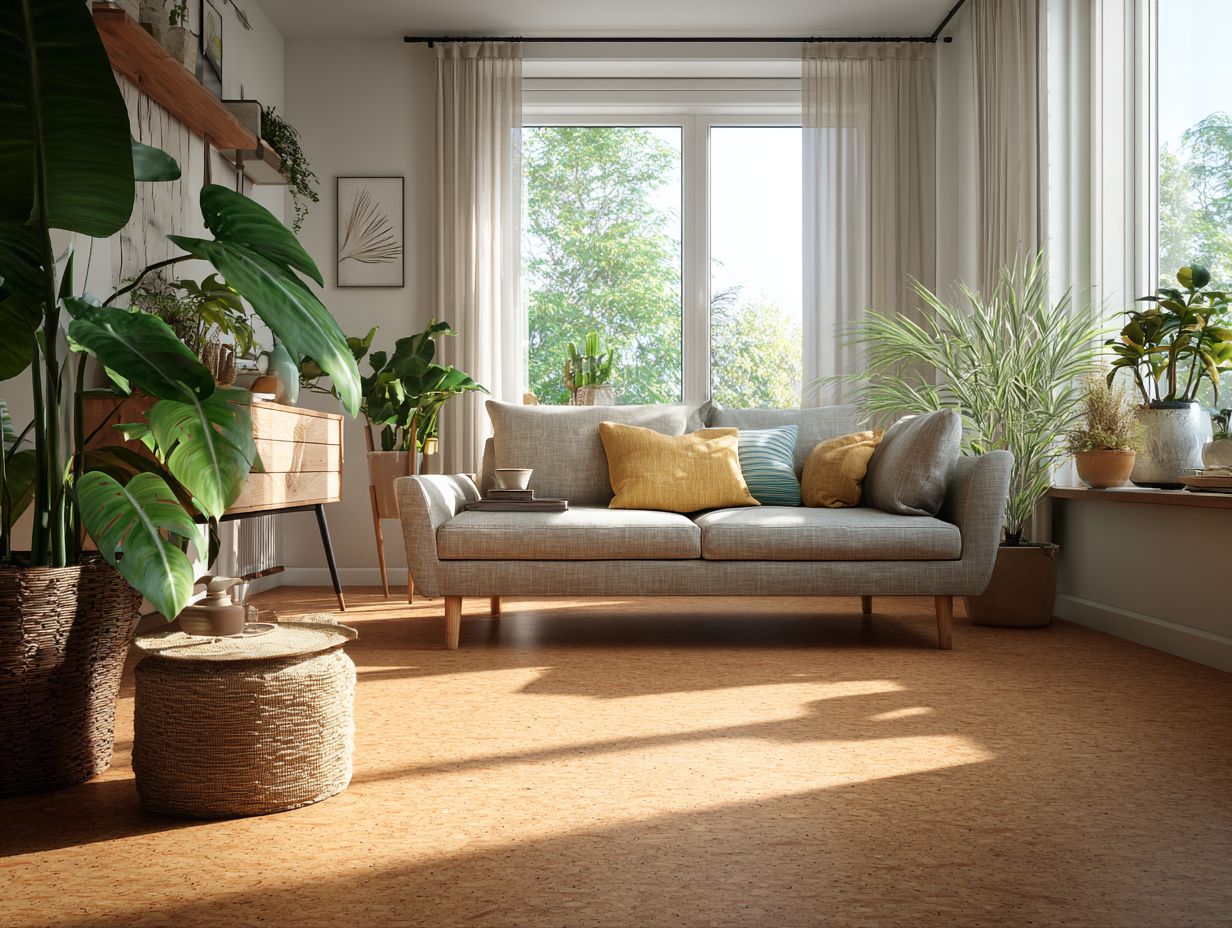
Having a consistent cleaning schedule matters; using a vacuum with a HEPA filter and mopping every week can greatly reduce allergens on your floors.
To improve your cleaning routine, try these specific methods for hypoallergenic flooring types.
- For hardwood floors, use a damp microfiber mop with a gentle pH-neutral cleaner designed for wood.
- For laminate, opt for a dry mop followed by a slightly damp one to avoid water damage.
- If you have tile or vinyl, a solution of warm water and white vinegar works wonders.
Always test new products in a hidden area to prevent any potential damage and adjust your cleaning frequency based on foot traffic.
Preventing Allergen Buildup
To prevent allergen buildup in your home, strategic measures such as using entry mats and setting up a no-shoe policy can be highly effective.
Plus these strategies, consider regular cleaning habits. Vacuum with a HEPA filter at least once a week to trap dust and allergens effectively.
Use damp cloths for dusting surfaces, as dry dusters can just move particles around. Maintaining a humidity level of 30-50% with a dehumidifier can inhibit mold growth.
Opt for air purifiers in frequently used areas to continuously filter out airborne allergens. These combined efforts create a healthier indoor environment, limiting allergen exposure significantly.
Frequently Asked Questions
What are some hypoallergenic flooring options for people with allergies?
Some hypoallergenic flooring options for people with allergies include hardwood, bamboo, laminate, tile, and vinyl. These materials don’t hold onto dust, allergens, and other irritants, making them a good option for people with allergies.
How does flooring impact allergies?
Flooring can play a significant role in triggering allergies. Materials like carpet can hold onto dust, mold, and other allergens, which can be harmful to people with allergies. Choosing hypoallergenic flooring can help reduce the presence of these irritants in the home.
Is carpet a good option for people with allergies?
No, carpet is not a good option for people with allergies. It can collect dust, pet hair, and other allergens, creating a place where irritants can thrive. If you have allergies, it’s best to choose a hypoallergenic flooring option, such as hardwood or tile.
Can laminate flooring be hypoallergenic?
Yes, laminate flooring can be hypoallergenic if it is made with hypoallergenic materials. Avoid laminate with a high percentage of formaldehyde, as this can be an irritant for those with allergies. Look for laminate made with low or no VOCs (volatile organic compounds).
Are there any eco-friendly hypoallergenic flooring options?
There are eco-friendly flooring choices that are hypoallergenic, such as bamboo and cork. These materials are reusable and promote lasting environmental well-being, making them a great choice for people looking for eco-friendly alternatives. They also do not trap allergens as much, which is good for people with allergies.
How can I maintain hypoallergenic flooring?
To maintain hypoallergenic flooring, it’s important to keep it clean and free of dust and other irritants. Regularly vacuum and sweep the floors, and avoid using harsh chemicals or cleaners that can trigger allergies. It’s also a good idea to remove shoes at the door to prevent tracking in allergens from outside.
